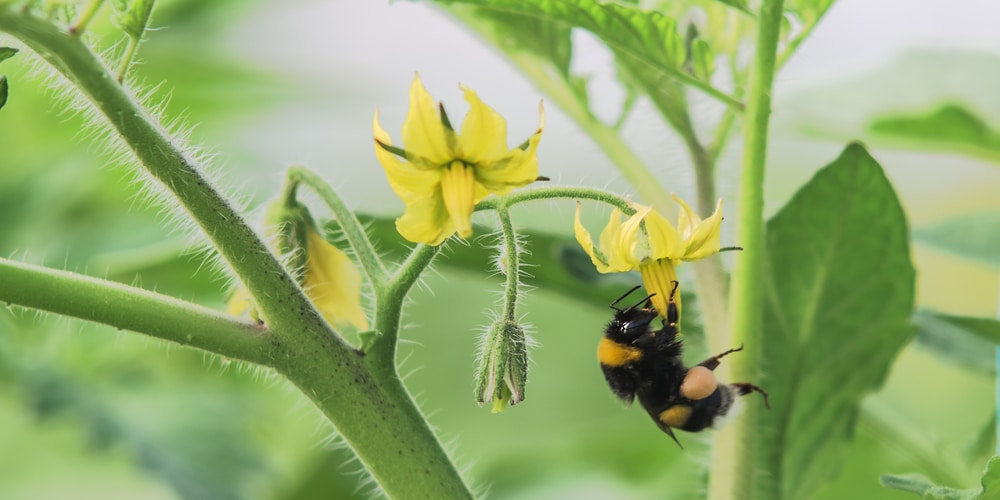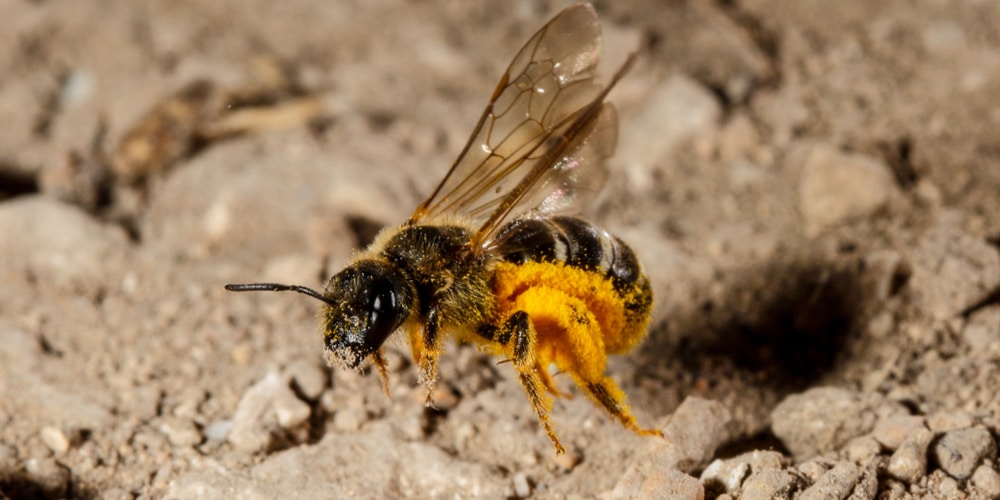Ground Bees: 101
The buzz in your backyard could be due to ground bees. Let’s dig into how you can spot these burrowing buzzers!
Key Characteristics:
- Holes in Dry Soil: Look for small mounds of earth, similar to what you’d see with anthills, but with larger openings. Ground bees prefer dry, sandy soil to call home.
- Visible Flight Paths: Observe bees flying low to the ground. Unlike their tree-loving cousins, ground bees can often be seen zipping in and out of their earthy abodes.
Types of Ground Bees:
- Mason Bees: Metallic blue or green, fond of making nests in reeds.
- Sweat Bees: Small, attracted to perspiration, enjoy flowers.
- Leafcutter Bees: Carry circular cutouts from leaves, gentle pollinators.
- Digger Bees: Large and solitary, often mistaken for bumblebees.
- Mining Bees: Hairy and dark, vastly useful for early spring pollination.
Activity Signs:
- Morning Hustle: Most active during morning hours.
- Temporary Tenants: Only present in your yard from spring to early summer.
Ground bees are usually non-aggressive and tend to avoid human contact. If you’re experiencing a lot of buzzing visitors, chances are they’re enjoying your garden as much as you do! Keep an eye out for their unique traits and respect their role in our ecosystem. For detailed descriptions, check out the various types of ground bees and their behaviors.
Preventive Measures
Taking proactive steps to manage your outdoor space can keep ground bees at bay. Let’s dig into how you can maintain a less inviting yard for these buzzy inhabitants.
Maintaining Your Yard
- Keep it Trimmed: Regularly cut your grass to discourage ground bees from nesting. They prefer longer grass for cover.
- Remove Bare Spots: Plant ground cover or spread mulch over bare patches of soil, as ground bees are attracted to exposed dirt for their nests.
- Limit Flowering Weeds: Bees are drawn to flowers, so it’s essential to pull weeds to avoid unintentional bee buffets.
Creating Unfavorable Conditions
- Reduce Moisture: Ground bees like damp soil. Ensure proper yard drainage and fix any leaky faucets or hoses.
- Avoid Overwatering: Stick to a watering schedule that keeps plants healthy but doesn’t create puddles or overly wet soil attractive to bees.
Natural Removal Methods
When addressing ground bee issues in your yard, it’s best to start with eco-friendly and bee-safe remedies. Let’s explore some of the clever tactics that don’t harm these buzzing pollinators.
Dousing With Water
- Simple Flooding: Gently flood the nesting area with water to encourage ground bees to relocate. Use a garden hose to apply about 1 inch of water over the nesting site.
- When to Water: Perform this action in the early morning or late evening, when bees are less active.
- Frequency: Do this once a week during their active season to prevent them from establishing their nests.
For detailed methods and timing, check out ways to flood ground bee nests.
Using Cinnamon
- Cinnamon Dusting: Ground bees are not fans of cinnamon! Sprinkle it around their entrances to encourage them to pack up and move.
- Application: Apply a light dusting daily for a few days until you notice a reduction in bee activity.
Using cinnamon is an effective way to repel ground bees without causing them harm. For more insights into this method, learn about repelling bees with cinnamon.
Chemical Solutions
When you’re dealing with ground bees, chemical solutions can be effective, but they should be your last resort due to potential harm to the environment and beneficial insects. If you’ve decided to go this route, there are a few options you can consider:
- Insecticidal Dust:
- Purchase insecticidal dust formulated for bees.
- Apply it directly to the nest entrance during dusk or dawn when bees are less active.
- Ensure you’re wearing protective clothing to prevent stings.
- Liquid Insecticides:
- These can be sprayed into the nest entrance, but they require careful handling.
- Look for products specifically designed to target ground bees.
- Soapy Water Mixture:
- A homemade solution of soapy water can be surprisingly effective.
- Mix dish soap with water in a ratio of 1-part soap to 4-parts water.
- Pour it into the nest entrance to encourage bees to abandon the nest.
Remember:
- Follow all instructions on the label of any chemical products.
- Protect non-target insects by applying these treatments at night when bees and other pollinators are inactive.
- Consider the impact on the environment before opting for chemical solutions.
When to Seek Professional Help
Dealing with ground bees can be a tricky business. You’ve got to know when it’s time to call in the pros! Here are some clear signs that professional help is needed:
- Allergic Reactions: If you or a family member has a history of severe allergic reactions to bee stings, don’t take chances. Professional pest control experts can handle the bees safely.
- Large Infestations: Can’t seem to pinpoint where those pesky bees are coming from because there are just too many? This could be a sign of a large infestation.
- Protected Species: Some bees are protected, and you could get into legal trouble for handling them improperly. If you suspect the bees might be a protected species, let the experts handle it.
- Recurring Problems: Have you tried everything under the sun to get rid of ground bees but they keep coming back? This could indicate a larger issue that requires professional intervention.
Taking action:
- Identify the severity of the problem.
- Contact local pest control services—opt for ones that specialize in bee removal.
- Discuss non-lethal removal and rehoming options; these methods are bee-friendly!
- Ensure the safety of everyone involved, especially if the bees are aggressive.
Frequently Asked Questions
Discovering ground bees in your yard can be a striking find, but managing their presence doesn’t have to be a stinger of a problem. Let’s buzz through some common questions to keep your outdoors a friendly buzz-free zone.
What methods can be used to remove ground bees without causing harm to them?
You can encourage ground bees to relocate by watering the area regularly since they prefer dry soil for their nests. Additionally, planting strong-smelling plants can deter them from setting up camp in your yard.
Are there effective natural remedies to deter ground bees from nesting in my yard?
Indeed, there are several natural remedies to consider:
- Sprinkling cinnamon near the nest entrances daily can encourage bees to move on.
- A mixture cool peppermint soap solution poured into the nest can also be unwelcoming to ground bees.
Can vinegar be utilized as a solution for repelling ground bees, and how?
You can use vinegar as a repellent for ground bees:
- Mix equal parts white vinegar and water to create a spray.
- Apply directly to nests or bees with caution to discourage them as suggested by This Old House.
What are the risk factors of ground bee stings, and how can I prevent them?
Ground bee stings can cause allergic reactions in some people. To prevent stings:
- Wear protective clothing when near their nests.
- Avoid perfumes or scented products that attract bees when you’re outside.
How long is the typical nesting period for ground bees in one location?
Ground bees typically nest from early spring to late summer. Most ground bee species will nest in the same location for about four to six weeks.
What attractants should I eliminate to prevent ground bees from settling in my area?
Be mindful of what may attract ground bees:
- Remove exposed soils by laying down mulch or planting ground cover.
- Keep trash cans sealed to prevent bees from being lured by sweet substances or food.
Last update on 2025-06-06 / Affiliate links / Images from Amazon Product Advertising API





